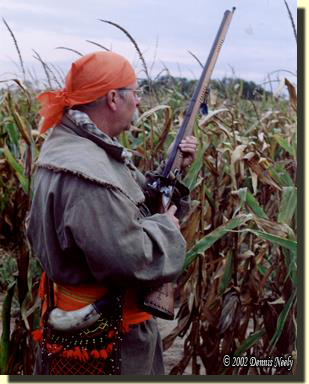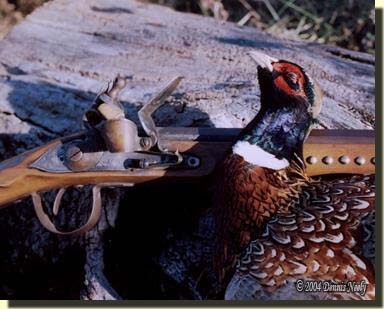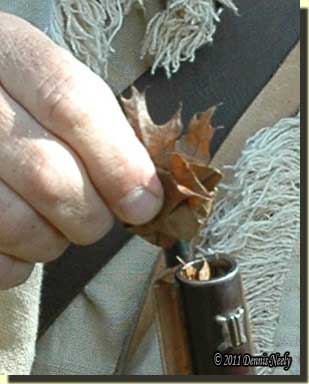Muffled wing beats rumbled. A reddish-brown blur rose in the grey soup of morning vapor. The fowl dropped into a thick patch of sedge grass, thirty or so paces east of its night roost. Overnight dew drenched each slender, tawny blade of prairie grass. Silver droplets splashed and scattered as trail-worn buckskin leggins crept along. Likewise, greased elk moccasins did little to fend off the inevitable soaking.
Despite unseasonable warmth, the humid scent of damped goldenrod stems, rich, black earth and a hint of wild mint left little doubt fall had arrived in the Old Northwest Territory. Faint, yellow streaks emerged from behind the eastern tree line. And yet, the misty haze that hung all about the nameless creek grew thicker, perhaps even with a slight chill. Such was that October morning, in the Year of our Lord, 1796.
That 18th-century frolic was a diversion of sorts. The post hunter’s course was erratic, zigging and zagging, first left, then right, with a turn-about or a pause thrown in, all with the sole purpose of unnerving one of those luscious fowls. After the rooster rose up like a specter in the night, the woodsman’s mouth salivated at the thought of a white, tender breast-half roasting on a pointed stick over the evening fire. The craving overtook his thoughts when he first awoke.

The Northwest trade gun’s turtle sight fidgeted to and fro out over the sopping tangle. A hefty swarm of death bees mingled in the breech, packed tight with ample wadding. An eager thumb maintained a gentle, hopeful pressure on the domed jaw screw that secured a sharp, English flint. All the while, bare hands, guided by unconscious knowing, maneuvered the smoothbore’s firelock around any treacherous, dripping foliage that might wet the pan’s priming.
Overhead, a milling flock of cawing, black demons winged hard to the west and the morning melee that had already erupted in the hardwoods. A chipping sparrow tottered on a red willow shoot, but did not sing. This tiny forest tenant followed the woodsman, flying out and around, then landing square in front of the Northwest gun’s muzzle. It was hard to not notice.
The still-hunt, nay, the erratic dance reserved for the fowls of the fen, continued in the direction of that first rooster. But the hired hunter, out on a simple pursuit of his own pleasure, did not wish to miss any opportunity at a bird crouched in seclusion between the wagon trail and that patch of sedge grass. And at that thought, his mouth watered again…
Common Northwest Gun Questions
I knew better than to answer William’s comment to “Big sigh…guilty as sinned” with another comment. I hope you don’t mind, sir, but your thoughts touched on a number of issues that are common questions among traditional black powder hunters.
Northwest guns might be called the “Model T” of trade guns. They were produced by contract from the late-1750s to the early-1930s. In general, depending on what trading company or partner placed the order, the specifications were sometimes vague, sometimes specific. Yet despite the discrepancies, the pattern for a Northwest gun was well established by the 1790s.

I don’t recall seeing any published statistic on the length of pull. From the originals I have viewed, that dimension varies from 13 1/2 inches to 14 inches. A 15-inch LOP was uncommon. That said, my son-in-law has long arms and needs a 15-inch LOP, which required a custom butt stock. From a modern perspective, a gun made to fit the owner is best. The idea is to enjoy shooting black powder and traditional hunting; fighting a short or long stock is no fun.
Curly Gostomski, the founder of North Star Enterprises in the mid-1960s, started making reproduction Northwest trade guns patterned after the “Barnett” and “Wheeler” guns. He was one of the first to promote the versatility of the Northwest gun—and he was a lefty. To my knowledge, he was the first to offer a left-hand trade gun lock, other than custom made locks.
I met Curly on my first trip to the National Muzzle Loading Rifle Association, in Friendship, Indiana. On the surface, he was gruff, with a sun-weathered complexion, but the grizzled exterior and abrupt manner melted away when he started pontificating about the virtues of the Northwest trade gun. He was a wealth of knowledge.
I purchased the last trade pistol he ever produced. I hope that is not the same sales pressure as “I purchased the last room available at this hotel…” I have three of his pistol barrels, bought off trade blankets at Friendship, a blanket gun barrel and two longer barrels. Not one of them matches in bore diameter, which I was told was standard practice for Curly, especially in his later years. Several people have told me he made his own barrels, and the bore was determined by how he tooled up for a given batch run.
Most of his barrels that I’ve seen are .600 of an inch, give or take a thousandth or three, but he made “16-gauge” and “12-gauge” guns, too. The barrels I have range from .600 of an inch to .617 of an inch, yet are all considered “20-gauge.”
When I built “Old Turkey Feathers” there was no consistency among manufacturers. The barrel came from Track of the Wolf, and in the late 1970s, all of their 20-gauge barrels measured .620 of an inch. A number of years ago, there was a shortage of barrels and barrel makers for smoothbores. The barrel that came with the Track of the Wolf kit mentioned in the previous post, measures .600 of an inch, and a Track of the Wolf representative said that the “interim maker” was tooled for the .600 of an inch bore.
The English shotgun bore size for a 20-gauge is .615 of an inch. After the barrel shortage, some manufacturers gravitated to that “true bore size,” including Track of the Wolf—and some did not. Thus the discrepancies still exist. But that is no different than the varied bore diameters found on the originals.

Old Turkey Feathers has had a rough life, but that trade gun is over forty years old—and a “go-to gun” at that. I started to show some wear and tear at that age, too. That barrel has belched out more than 12,000 rounds, probably closer to 15,000. I used to keep track of the count by the number of .125 cards used. I kept notes, too, but with the lure of natural wadding, the actual count got away from me about ten years ago.
From time to time, I’ve honed the bore, too. That’s another story, but the end result is that between honing and shooting Old Turkey Feathers now measures .628 of an inch, or just over a “19-gauge” by the English shotgun bore size chart in the back of the Dixie Gun Works catalog (2014, pg. 613).
“Gauge” refers to the number of balls that can be cast from a pound of lead that fit the bore of the gun. Thus, “20-gauge” means 20 balls to the pound. A .600 of an inch diameter ball (equivalent to the .600 of an inch bore size) weighs out at 21.5 per pound. A .620 of an inch diameter ball weighs out to 19.5 per pound, so a .615 of an inch bore falls real close to 20 balls per pound (ibid, 612).
Give traditional black powder hunting a try, be safe and may God bless you.



2 Responses to Not Much Changes…